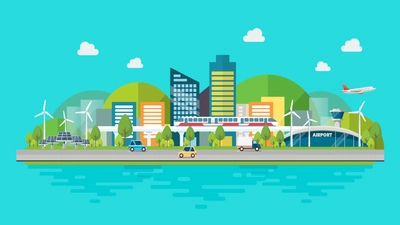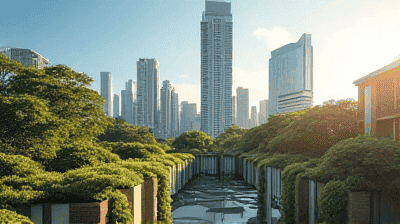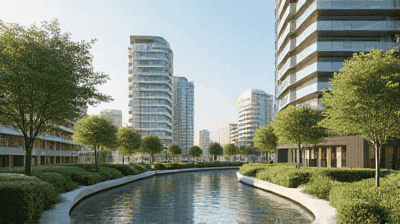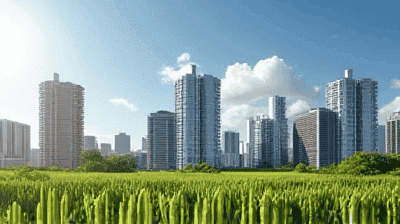
As urban areas continue to expand, the need for sustainable development practices is more critical than ever. One of the most influential frameworks guiding this transition is LEED certification, which stands for Leadership in Energy and Environmental Design. Developed by the U.S. Green Building Council (USGBC), LEED provides a comprehensive set of standards for green building design, construction, operations, and maintenance.
LEED certification is a globally recognized symbol of sustainability achievement. It facilitates the development and maintenance of buildings that are efficient, environmentally friendly, and sustainable. Buildings can earn LEED certification in several categories, including residential, commercial, and neighborhood developments.
The LEED rating system evaluates buildings across various domains, assigning points for fulfilling criteria in the following categories:
Location and Transportation (LT): Encourages building in sustainable locations and promoting alternative transportation.
Sustainable Sites (SS): Focuses on site selection, landscaping, and minimizing environmental impact.
Water Efficiency (WE): Addresses water consumption and incorporates strategies to reduce usage.
Energy and Atmosphere (EA): Encourages energy efficiency measures and the use of renewable energy sources.
Materials and Resources (MR): Promotes sustainable sourcing of materials and waste reduction practices.
Indoor Environmental Quality (EQ): Focuses on creating healthy indoor environments for occupants.
Innovation (IN): Allows for additional points for innovative strategies that enhance sustainability.
Regional Priority (RP): Addresses specific environmental issues prevalent in the project's region.
Buildings achieve a certain level of certification—Certified, Silver, Gold, or Platinum—based on the total points earned.

LEED certification plays a pivotal role in shaping sustainable urban development through several key mechanisms.
The building sector is one of the largest consumers of energy and contributes significantly to greenhouse gas emissions. LEED-certified buildings prioritize energy efficiency through:
Optimized Energy Performance: LEED incentivizes the installation of high-efficiency HVAC systems, lighting, and appliances, helping to reduce overall energy consumption.
Renewable Energy Utilization: LEED promotes on-site renewable energy generation, such as solar panels or wind turbines, which drastically cut energy costs and reduce dependence on fossil fuels.
LEED certification encourages thoughtful site selection and development practices that minimize negative impacts on the environment. Key strategies include:
Location Sensitivity: LEED-certified buildings are often located in areas with access to public transportation, reducing reliance on cars and encouraging walkability.
Ecosystem Preservation: Site development considers the preservation of natural habitats and biodiversity, promoting ecological balance.
Water scarcity is an increasingly pressing issue in many urban areas. LEED certification focuses on reducing water usage through:
Water-Efficient Fixtures: Installing low-flow faucets, toilets, and irrigation systems significantly lowers overall water consumption.
Stormwater Management: LEED encourages the use of green roofs, permeable pavements, and landscaping that absorbs rainwater, reducing runoff and mitigating flooding risks.
A significant aspect of urban development is ensuring the health and well-being of occupants. LEED-certified buildings provide:
Quality Indoor Air: Emphasis on low-VOC materials and proper ventilation systems leads to healthier indoor air quality, benefiting the health of occupants.
Natural Light and Views: LEED promotes the inclusion of windows and skylights to provide natural daylight and views of the outdoors, enhancing the occupant experience.
Sustainable urban development through LEED certification not only benefits the environment but also stimulates economic growth:
Increased Property Values: LEED-certified buildings often experience higher market values and lower vacancy rates, making them attractive investments.
Job Opportunities: The push for green building practices has led to the creation of jobs in fields such as energy auditing, green construction, and sustainable architecture.
LEED certification offers numerous advantages for building owners, occupants, and the broader community.
Reduced Operating Costs: Energy-efficient buildings have lower utility bills, affecting the overall operating costs positively.
Government Incentives: Many governments provide tax credits, grants, or reduced permit fees for LEED-certified projects, incentivizing investment in sustainable building practices.
Return on Investment: Research shows that LEED-certified buildings achieve higher returns on investment over time due to their lower operational costs and greater marketability.
Climate Change Mitigation: By reducing energy consumption and greenhouse gas emissions, LEED-certified buildings contribute to climate change mitigation efforts.
Waste Reduction: LEED emphasizes recycling and material reuse, reducing the environmental impact associated with waste disposal.
Biodiversity Preservation: Strategies that focus on better site selection and landscaping contribute to preserving urban biodiversity.
Enhanced Indoor Environments: Improved air quality, natural lighting, and the use of healthy materials contribute to a better quality of life for occupants.
Community Well-being: LEED-certified buildings promote well-designed outdoor spaces that encourage physical activity, social interaction, and mental well-being.

As cities face increasingly complex challenges posed by climate change, economic shifts, and population growth, resilience becomes a crucial component of sustainable urban development. LEED certification plays a significant role in building resilience through:
LEED-certified buildings often incorporate design features that help mitigate the impacts of climate change:
Flood-Resilient Design: Integrating strategies such as elevated structures and permeable surfaces helps to address flooding issues in vulnerable areas.
Heat Mitigation: Green roofs and strategic landscaping help reduce the urban heat island effect, improving thermal comfort and reducing energy consumption.
Sustainable urban development that prioritizes LEED certification promotes social equity through:
Affordable Housing: LEED principles can be applied to affordable housing projects, ensuring that all community members benefit from healthier living environments.
Community Engagement: Projects that involve local stakeholders in the planning process foster a sense of ownership and engagement over community resources.
Despite its many benefits, the widespread adoption of LEED certification faces several challenges:
The initial investment for LEED certification, including the cost of green materials, energy-efficient systems, and certification fees, can be a barrier for some developers. However, it is important to weigh these costs against long-term savings.
The LEED certification process can be complex and may require expertise that some project teams might not possess. Educating all stakeholders about the benefits and requirements of LEED is critical for successful implementation.
As sustainability becomes a growing trend, some companies may engage in "greenwashing"—claiming environmental benefits without true evidence. This can undermine the legitimacy of LEED certification. Ensuring transparency and communication of actual sustainable practices is vital.
LEED continuously adapts to reflect emerging sustainability practices and technologies. While this is beneficial, it creates challenges for building owners and developers who may find it difficult to stay abreast of the latest changes.

As urban areas evolve, the future of LEED certification holds exciting possibilities that will shape sustainable development:
Future iterations of LEED certification may increasingly emphasize performance outcomes over prescriptive measures. This shift would focus on actual building performance results, encouraging more innovative and customized approaches to sustainability.
The use of smart building technologies, such as energy monitoring systems and building automation, will enhance data collection and reporting. This will allow for more precision in tracking energy usage, indoor air quality, and occupant comfort.
LEED is likely to incorporate more life-cycle assessment principles, evaluating the sustainability of materials not just based on their installation but throughout their entire life cycle—from extraction to disposal.
As awareness of sustainability grows worldwide, LEED certification is expected to expand its influence internationally. Adapting the certification process to resonate with diverse cultural and geographic contexts will enhance its global impact.
Future LEED standards may increasingly advocate for social equity, focusing on the equitable distribution of environmental benefits. This could involve ensuring that underrepresented communities have access to sustainable housing and resources.
To illustrate the impact of LEED certification on sustainable urban development, we can look at several notable projects.
This iconic skyscraper achieved LEED Gold certification through its focus on energy efficiency, sustainable materials, and improved indoor environmental quality.
Energy Efficiency Measures: The building incorporates a high-performance façade and energy-efficient systems that resulted in significant energy savings.
Sustainable Materials: One World Trade Center utilized a substantial amount of recycled steel and locally sourced materials.
Dubbed the "greenest commercial building in the world," the Bullitt Center achieved rigorous sustainability goals, including a net-zero energy target.
Renewable Energy: The building's rooftop solar array generates more electricity than it consumes over the course of a year.
Water Management: The Bullitt Center incorporates a rainwater harvesting system that supplies all potable water needs.
The San Francisco Green Building showcases an interconnected approach to environmental stewardship, earning LEED Gold certification.
Community Engagement: The building design process involved extensive input from community stakeholders, leading to features that benefit the local neighborhood.
Waste Diversion: Innovative waste management practices diverted a significant percentage of construction waste from landfills.
LEED certification has established itself as a cornerstone of sustainable urban development, guiding the building industry toward practices that prioritize energy efficiency, environmental responsibility, and community well-being. By promoting the use of sustainable materials and practices, LEED not only fosters ecological preservation but also drives economic growth and enhances quality of life.
As urban challenges continue to mount, embracing LEED certification will become increasingly essential for creating resilient, healthy, and sustainable cities. Collaborating across disciplines, engaging stakeholders, and innovating practices will help advance LEED's role in shaping the future of urban development. By investing in sustainable solutions today, we can ensure a brighter and more sustainable tomorrow for generations to come.